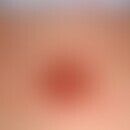Synonym(s)
HistoryThis section has been translated automatically.
DefinitionThis section has been translated automatically.
Very rare, generalized disease (Omin: 149500) characterized by follicular and perifollicular (?) papules with firmly attached horny deposits. The existence of the disease is disputed by several authors.
You might also be interested in
EtiopathogenesisThis section has been translated automatically.
In elderly patients, associations with diabetes mellitus and chronic renal insufficiency have been described, as well as triggering by dialysis (Detmar M et al. 1990). However, these cases are probably attributable to"reactive perforating collagenosis"!
ManifestationThis section has been translated automatically.
First manifestation in childhood or younger adulthood. Gynecotropy(?).
LocalizationThis section has been translated automatically.
ClinicThis section has been translated automatically.
Asymptomatic, isolated, occasionally grouped, follicular, yellowish to brownish red, sometimes verrucous horny nodules. Confluence to larger polycyclic hyperkeratotic plaques is described (also in the original 1916 publication by J. Kyrle). The horny plaques can be detached, leaving a bowl-shaped loss of substance with an oozing and slightly bleeding base (description from the original publication). Healing with superficial pigmented scars. No itching. Koebner's phenomenon is negative.
HistologyThis section has been translated automatically.
Differential diagnosisThis section has been translated automatically.
External therapyThis section has been translated automatically.
Keratolytic, e.g., with external retinoids(tretinoin cream hydrophilic 0.025/0.05 or 0.1% (NRF 11.101.) , salicylic acid-containing externals salicylic acid ointment (W/O) or urea-containing externals urea cream hydrophilic 5 or 10% (NRF 11.71.).
Internal therapyThis section has been translated automatically.
A proven effective therapy is not known: an experiment with acitretin (neotigason) can be performed, first for about 6 weeks in high doses of 0.5-1 mg/kg bw/day, then reduction to maintenance dose of 0.25-0.5 mg/kg bw/day. Successful therapy attempts with allopurinol (e.g. Zyloric) are described on the basis of casuistics (level of evidence IV).
Operative therapieThis section has been translated automatically.
Progression/forecastThis section has been translated automatically.
LiteratureThis section has been translated automatically.
- Ataseven A et al (2014) Kyrle's disease. BMJ Case Rep doi: 10.1136/bcr-2013-009905.
- Cunningham MB et al (1987) Kyrle`s disease. J Am Acad Dermatol 16: 117-123.
- Detmar M et al (1990) Kyrle disease in juvenile diabetes mellitus and chronic renal failure. Z Hautkr 65: 53-61
- Dharmadji HP et al (2022) Generalized lesions of Kyrle's disease: A rare case. Int Med Case Rep J 15:187-191.
- Iyoda M et al (2003) Acquired reactive perforating collagenosis in a nondiabetic hemodialysis patient: successful treatment with allopurinol. Am J Kidney Dis 42: E11-13.
- Kawakami T et al.(2020) Guideline: Clinical practice guide for the treatment of perforating dermatosis doi.org/10.1111/1346-8138.15647
- Kruger K et al (1999) Acquired reactive perforating dermatosis. Successful treatment with allopurinol in 2 cases. Dermatologist 50: 115-120
- Kyrle J (1916) On an unusual case of universal follicular and parafollicular hyperkeratosis (Hyperkeratosis follicularis et parafollicularis in cutem penetrans). Arch Derm Syph 123: 466-493
- Rallis E et al (2014) Squamous cell carcinoma developed on Kyrle's disease scar. J BUON 19:317-318
- Schreml S et al (2011) Kyrle disease and acquired perforating collagenosis secondary to chronic renal failure and diabetes mellitus. Case Rep Dermatol 3:209-211.
Incoming links (12)
Collagenosis reactive perforating; Dermatosis perforating; Elastosis perforans serpiginosa; Folliculitis perforating; Hyperkeratosis cyrle; Hyperkeratosis penetrans; Kyrle's disease; Kyrle syndrome; Renal diseases skin changes; Salicylic acid ointment (w/o); ... Show allOutgoing links (18)
Acitretin; Chronic prurigo; Collagenosis reactive perforating; Cryosurgery; Curettage; Dyskeratosis follicularis; Elastosis perforans serpiginosa; Excision; Granuloma anulare classic type; Hypertrophic Lichen planus; ... Show allDisclaimer
Please ask your physician for a reliable diagnosis. This website is only meant as a reference.












